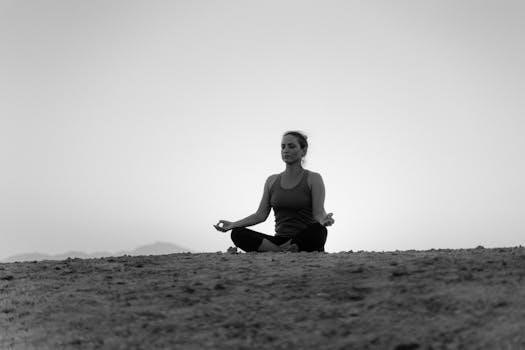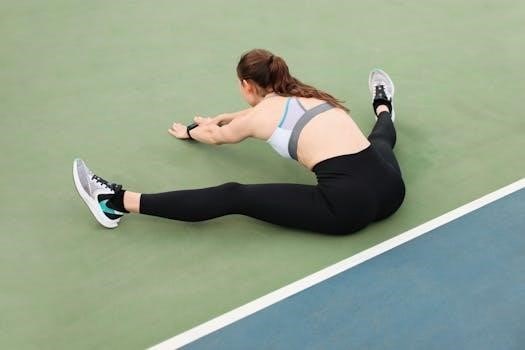Hamstring Stretching Exercises⁚ A Comprehensive Guide
This comprehensive guide provides valuable information on hamstring stretches, offering PDF resources for easy access. Explore various techniques to improve flexibility and alleviate tightness. Regular hamstring stretching provides numerous benefits. This guide offers proper methods for injury prevention.
Hamstring flexibility is crucial for overall physical health and athletic performance. The hamstrings, located at the back of the thigh, consist of three muscles⁚ semitendinosus, semimembranosus, and biceps femoris. These muscles play a vital role in knee flexion and hip extension. Limited hamstring flexibility can lead to various issues, including lower back pain, knee problems, and increased risk of injury during physical activities.
Understanding the importance of hamstring flexibility is the first step toward incorporating effective stretching techniques into your routine. Tight hamstrings often result from sedentary lifestyles, improper training, or inadequate stretching after exercise. Regular stretching helps improve the range of motion, reduce muscle stiffness, and enhance athletic performance.
This guide will provide a comprehensive overview of hamstring stretching exercises, including seated and standing variations, dynamic stretches, and advanced techniques for athletes. It will also cover how to avoid injury during hamstring stretches and integrate them into your daily routine. Whether you’re an athlete, fitness enthusiast, or someone looking to improve their flexibility, this guide will provide valuable insights and practical tips. Additionally, the PDF resources will offer visual aids and step-by-step instructions for each exercise.
Benefits of Regular Hamstring Stretching
Regular hamstring stretching offers a multitude of benefits that extend beyond just improved flexibility. Enhanced hamstring flexibility contributes significantly to overall physical well-being and athletic performance. One of the primary advantages is the reduction of lower back pain. Tight hamstrings can pull on the pelvis, leading to increased strain on the lower back muscles. By stretching the hamstrings regularly, you can alleviate this tension and promote better spinal alignment.
Another key benefit is the prevention of injuries. Flexible hamstrings allow for a greater range of motion, reducing the risk of strains and tears during physical activities. This is particularly important for athletes who engage in high-impact sports or activities that require quick movements. Stretching also improves muscle elasticity, making the hamstrings more resilient to sudden stresses.
Improved posture is another notable advantage. Flexible hamstrings help maintain a neutral pelvic position, which supports proper spinal alignment and reduces the likelihood of postural imbalances. This, in turn, can alleviate discomfort in the neck, shoulders, and hips.
Furthermore, regular hamstring stretching can enhance athletic performance by increasing stride length, improving agility, and promoting more efficient movement patterns. It also helps to reduce muscle soreness and stiffness after exercise, facilitating faster recovery. Incorporating hamstring stretches into your daily routine can lead to a more comfortable, functional, and active lifestyle.

Common Hamstring Stretching Exercises (PDF Resources)
Several effective hamstring stretching exercises can be easily incorporated into your daily routine. These stretches target different areas of the hamstring muscles, promoting overall flexibility and reducing the risk of injury. To further assist you, we have compiled a list of readily available PDF resources that provide detailed instructions and visual aids for each exercise.
One of the most common and effective stretches is the seated hamstring stretch. This involves sitting on the floor with your legs extended and reaching towards your toes. It’s essential to maintain a straight back and avoid rounding the spine to maximize the stretch. Another popular option is the standing hamstring stretch, which can be performed by placing one foot on an elevated surface and leaning forward, keeping your back straight.
For a more dynamic approach, try leg swings. These involve swinging one leg forward and backward, gradually increasing the range of motion. This helps to improve flexibility and warm up the hamstring muscles before exercise. Another dynamic stretch is the walking hamstring stretch, where you take a step forward and reach towards your toes, alternating legs with each step.
The PDF resources linked below provide step-by-step instructions, illustrations, and modifications for each of these stretches, ensuring that you can perform them safely and effectively. They also offer guidance on how to progress your stretching routine as your flexibility improves. These resources are valuable tools for anyone looking to improve their hamstring flexibility and overall well-being.
Seated Hamstring Stretch Technique
The seated hamstring stretch is a fundamental exercise for improving flexibility in the hamstrings. To perform it correctly, begin by sitting on the floor with your legs extended straight in front of you. Ensure your back is straight and your core is engaged. If you find it difficult to sit upright with your legs fully extended, slightly bend your knees.
From this position, slowly reach forward towards your toes, keeping your back as straight as possible. Avoid rounding your spine, as this can put unnecessary strain on your lower back. Focus on initiating the movement from your hips, tilting your pelvis forward. If you cannot reach your toes, that is perfectly fine; simply reach as far as you comfortably can without forcing the stretch.
Hold the stretch for 20-30 seconds, breathing deeply throughout. You should feel a gentle pull along the back of your thighs. Avoid bouncing or jerking motions, as this can increase the risk of injury. To deepen the stretch, you can gently pull your toes towards you, further engaging the hamstrings.
To release the stretch, slowly sit back up, returning to the starting position. Repeat this stretch 2-3 times, focusing on maintaining proper form and breathing deeply. The seated hamstring stretch is a great way to improve flexibility and reduce tightness in the hamstrings, which can help prevent injuries and improve overall mobility. Remember to listen to your body and avoid pushing yourself too hard, especially if you are new to stretching.

Standing Hamstring Stretch Technique
The standing hamstring stretch is a convenient and effective way to improve hamstring flexibility. Begin by standing tall with your feet hip-width apart. Gently bend one knee while keeping the other leg straight. Place the heel of your straight leg on the ground, toes pointing upwards.
Maintain a neutral spine and avoid rounding your back. Slowly lean forward from your hips, keeping your back straight as you lower your chest towards your thigh. You should feel a stretch along the back of your straight leg. Avoid forcing the stretch; only go as far as you comfortably can.
To deepen the stretch, you can gently pull your toes towards your shin with your hand. Be sure to keep your knee straight but not locked. Hold the stretch for 20-30 seconds, breathing deeply throughout. Focus on relaxing your muscles and allowing the stretch to gradually increase.
Avoid bouncing or jerky movements, as this can lead to injury. To release the stretch, slowly return to the starting position by straightening up. Repeat this stretch 2-3 times on each leg, focusing on maintaining proper form and breathing deeply.
For balance, you may hold onto a chair, wall, or other stable object. This stretch is particularly useful for those who spend long periods sitting or engaging in activities that tighten the hamstrings. Remember to listen to your body and avoid pushing yourself too hard, especially if you are new to stretching. Regular practice of the standing hamstring stretch can improve flexibility and reduce the risk of hamstring injuries.
Dynamic Hamstring Stretches
Dynamic hamstring stretches involve controlled movements through a range of motion, preparing the muscles for activity. Unlike static stretches, which are held in place, dynamic stretches improve flexibility while also increasing blood flow and muscle activation. These stretches are ideal as part of a warm-up routine before exercise.
One example of a dynamic hamstring stretch is leg swings. Stand tall and swing one leg forward and backward, gradually increasing the range of motion. Keep your core engaged and maintain good posture throughout the movement. Avoid swinging too forcefully or losing control of the leg.
Another effective dynamic stretch is walking lunges with a hamstring stretch. Perform a lunge, and as you step forward, reach down and gently touch your toes or shin on the front leg. This adds a dynamic element to the lunge, stretching the hamstring; Remember to keep your back straight and your core engaged.
Alternatively, try torso twists with a leg extension. Stand with your feet shoulder-width apart and extend one leg out to the side while twisting your torso in the opposite direction. This stretch targets the hamstrings and obliques simultaneously.
These dynamic stretches should be performed for 10-15 repetitions on each leg. Focus on controlled movements and proper form rather than speed. It’s important to listen to your body and avoid pushing through any pain. Dynamic hamstring stretches help improve flexibility, increase blood flow, and prepare the muscles for more strenuous activity, reducing the risk of injury. They are an excellent addition to any pre-workout routine.
Hamstring Stretches for Sciatica and Lower Back Pain
Tight hamstrings can contribute to sciatica and lower back pain by pulling on the pelvis and increasing stress on the lower spine. Stretching the hamstrings can help alleviate this tension, reducing pain and improving mobility. Gentle and controlled stretches are crucial for individuals experiencing these conditions.
One effective stretch is the seated hamstring stretch with a towel. Sit on the floor with your legs extended in front of you. Loop a towel around the ball of one foot and gently pull back, keeping your knee slightly bent. Hold this position for 20-30 seconds and repeat on the other leg. This stretch allows for a controlled and gentle lengthening of the hamstring muscles.
Another beneficial stretch is the supine hamstring stretch. Lie on your back with your knees bent and feet flat on the floor. Bring one knee towards your chest and gently straighten your leg, using your hands or a towel to assist. Hold for 20-30 seconds and repeat on the other leg. This stretch minimizes pressure on the lower back.
The standing hamstring stretch with a slight bend is also helpful. Stand with one foot slightly in front of the other. Gently bend your front knee and lean forward from your hips, keeping your back straight. You should feel a stretch in the back of your thigh. Hold for 20-30 seconds and switch legs.
Remember to breathe deeply and avoid bouncing. It’s crucial to listen to your body and stop if you experience any sharp pain. Regular hamstring stretching can improve flexibility, reduce tension in the lower back, and alleviate symptoms of sciatica.
Advanced Hamstring Exercises for Athletes
For athletes seeking to enhance hamstring flexibility and performance, advanced exercises are essential. These exercises go beyond basic stretches, incorporating dynamic movements and resistance to improve muscle strength, elasticity, and range of motion.
One effective advanced exercise is the Nordic hamstring curl. This exercise requires a partner to hold your ankles while you slowly lower yourself towards the ground, engaging your hamstrings to control the descent. This eccentric strengthening exercise is highly effective in preventing hamstring injuries.
Another advanced exercise is the single-leg Romanian deadlift (RDL). Stand on one leg with a dumbbell in the opposite hand. Hinge at your hips, lowering the dumbbell towards the ground while keeping your back straight and your core engaged. This exercise improves hamstring strength, balance, and stability.
Glute-ham raises are also beneficial. This exercise requires a glute-ham developer (GHD) machine. Secure your feet in the footplate and lower your torso towards the ground, engaging your hamstrings and glutes to pull yourself back up. This exercise targets the entire posterior chain, improving strength and power.
Dynamic stretches, such as leg swings and walking lunges with hamstring stretches, can also be incorporated into an athlete’s routine. These movements improve flexibility and prepare the hamstrings for high-intensity activities.
Plyometric exercises, such as box jumps and single-leg hops, can further enhance hamstring power and explosiveness. These exercises should be performed with proper technique and under the guidance of a qualified coach or trainer.
Remember to progressively overload these exercises to continually challenge your hamstrings and promote further gains in strength and flexibility. Prioritize proper form and technique to minimize the risk of injury.
Avoiding Injury During Hamstring Stretches

Preventing injury during hamstring stretches is paramount for maintaining lower body health and avoiding setbacks in training. One crucial aspect is proper warm-up. Prior to stretching, engage in light cardio, such as jogging or cycling, to increase blood flow to the muscles and prepare them for stretching; Dynamic stretches, like leg swings and torso twists, can further enhance muscle readiness.
Avoid ballistic stretching, which involves bouncing or jerky movements. These movements can trigger the stretch reflex, causing the muscles to contract and increasing the risk of injury. Instead, opt for static stretches, holding each stretch for 20-30 seconds, or dynamic stretches performed with controlled movements.
Listen to your body. Stretching should feel like a gentle pull, not sharp pain. If you experience any pain, stop the stretch immediately; It’s better to err on the side of caution and avoid pushing yourself too far.
Maintain proper posture and alignment during stretches. Avoid rounding your back or locking your knees, as this can put unnecessary strain on your hamstrings and lower back. Engage your core muscles to stabilize your spine and maintain a neutral posture.
Gradually increase the intensity and duration of your stretches over time. Don’t try to force your body into a position it’s not ready for. Consistency is key, so aim for regular stretching sessions rather than infrequent, intense stretches.
If you have any pre-existing injuries or medical conditions, consult with a healthcare professional or physical therapist before starting a hamstring stretching program. They can provide personalized guidance and modifications to ensure your safety.
Integrating Hamstring Stretches into a Daily Routine
Making hamstring stretches a consistent part of your daily routine is essential for maintaining flexibility and preventing injuries. Find moments throughout your day when you can easily incorporate these stretches. For example, start your morning with a few simple stretches before you even get out of bed. A gentle seated hamstring stretch can be done while you’re enjoying your coffee or tea.
During the workday, take short breaks to stretch your hamstrings. A quick standing hamstring stretch or a modified forward fold can help relieve tension and improve circulation, especially if you spend long hours sitting. Set reminders on your phone or computer to prompt you to take these stretching breaks.
In the evening, dedicate a longer session to more focused hamstring stretches. This can be a great way to unwind after a long day and prepare your body for rest. Combine static stretches with dynamic stretches for a well-rounded routine.
Consider incorporating hamstring stretches into your existing workout routine. Whether you’re a runner, weightlifter, or simply enjoy regular exercise, stretching your hamstrings before and after your workouts can improve performance and reduce the risk of injury.
Be mindful of your body’s needs and adjust your stretching routine accordingly. If you’re feeling particularly tight or sore, spend a little extra time stretching your hamstrings. On days when you’re short on time, focus on a few key stretches that target the most problematic areas.

Remember, consistency is key. Even a few minutes of stretching each day can make a significant difference in your hamstring flexibility and overall well-being. Make it a habit, and your body will thank you.

